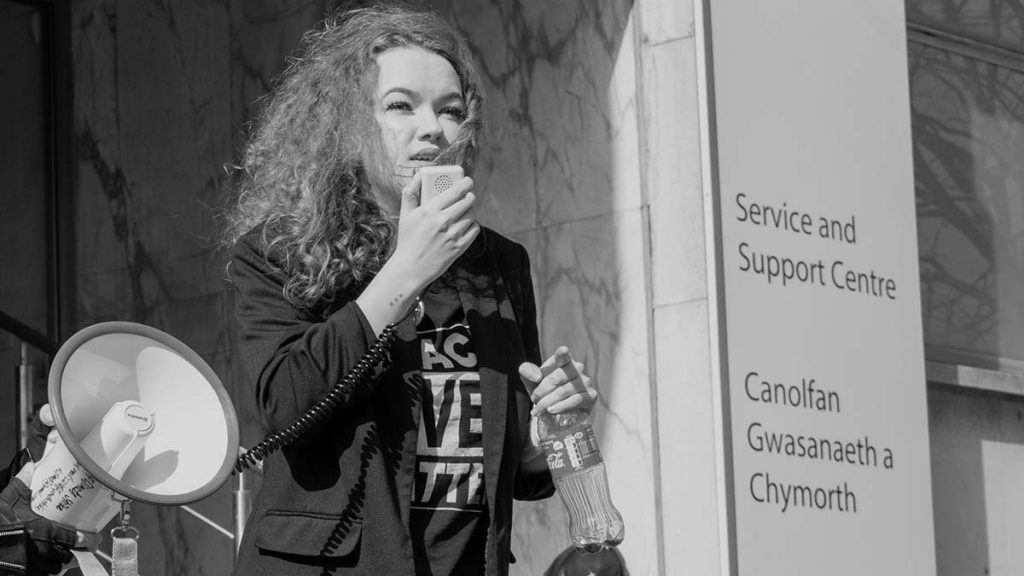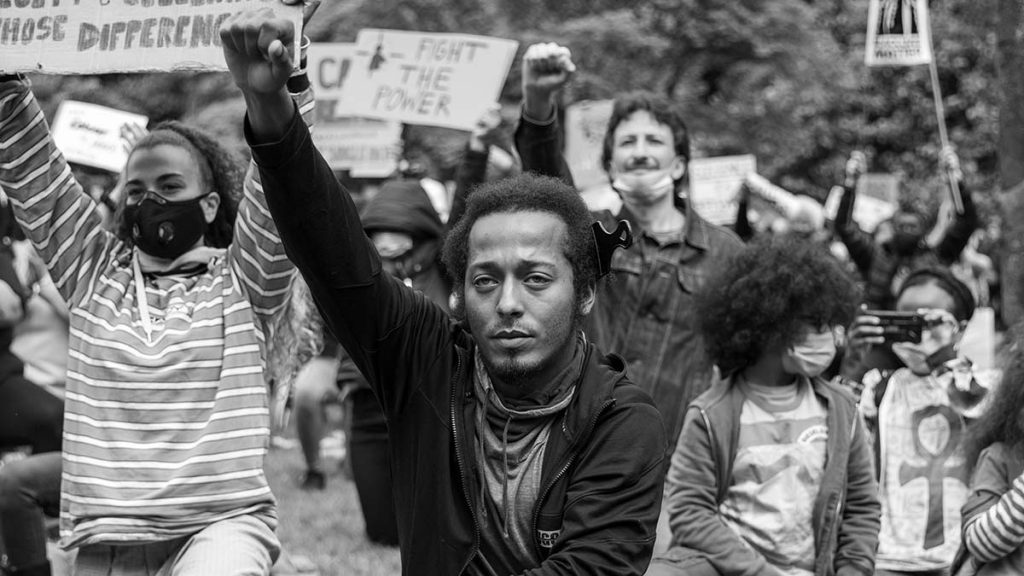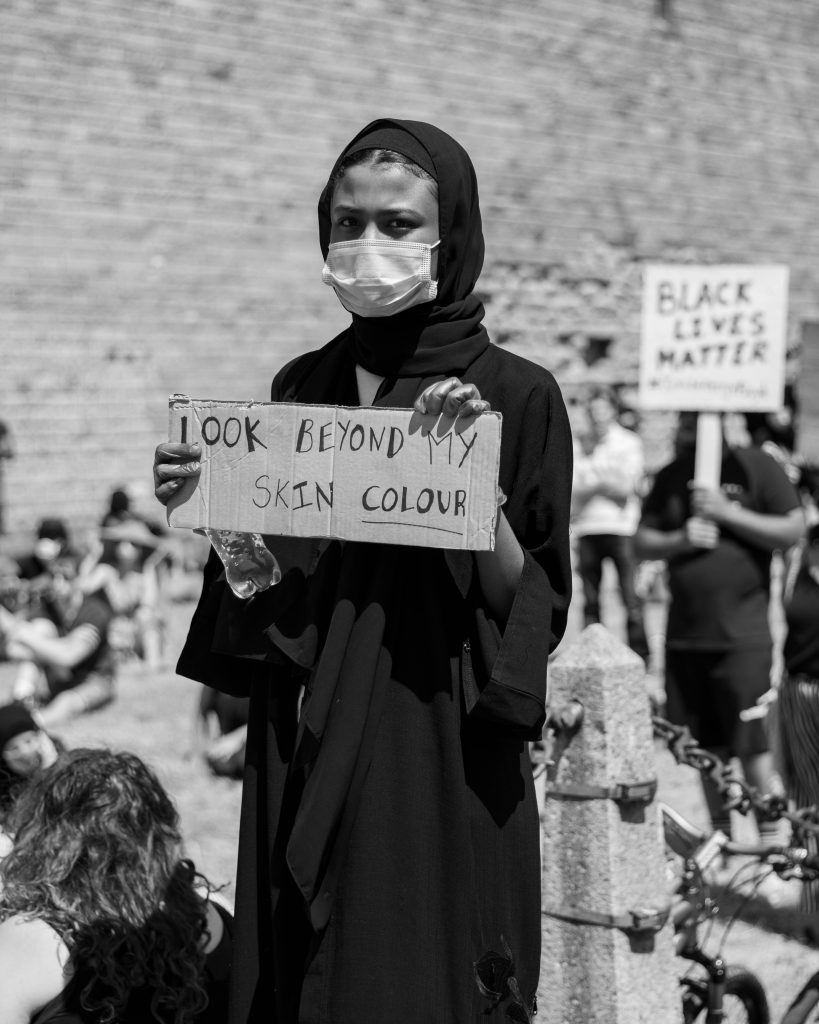One year after the murder of George Floyd, people are fighting more than ever against racial profiling and discrimination. How is the Black Lives Matter movement harnessing the power of digital technology to spread their campaign across the globe?

Darnella Frazier was on the way to the shop with her cousin when she saw the murder of George Floyd. She saw a man, on the ground, being held down by a police officer, pleading that he couldn’t breathe. So, she took out her phone and started filming.
“If that wasn’t recorded, nothing would have happened, and Derek Chauvin would have gotten away with it again and again and again,” says Lowri Davies, the leader of Black Lives Matter Swansea. “Had she not been there, had she not had a phone with her, nothing would have happened.”
When Rodney King was assaulted in 1992, it was by luck that it was filmed. But it wasn’t by chance for Floyd’s murder: everyone has a phone on them now. And because of this, anyone can become an activist, anyone can become a content creator. Posting everything you do or see is becoming more and more prevalent, highlighting injustices that the mainstream media, lawmakers, or governments don’t pick up, or won’t pick up.
“It is somewhat interesting but mainly upsetting to imagine what would have happened to the memory of George Floyd if we did not have social media,” writes Alice Gawthrop, an activist who did research on Black Lives Matter and activism. “The story might have been picked up by a few local news outlets, but it is quite likely that interest would have faded quickly, and George Floyd would have probably become just another in a long list of forgotten black people in America killed unjustly at the hands of the police.”
When Darnella shared the video online, it spread around the globe. Within ten days of posting, it had over 500 million views and was reposted across every social media platform possible. People were outraged. People wanted to see a change. And people turned towards the Black Lives Matter network for help.
Rallies happened all over the world. On June sixth, over half a million people joined protests all across the US, and throughout June, up to 25 million people joined in. Ten of thousands of people marched through the streets of European capitals, including Helsinki, Paris, and Berlin.
In Swansea, Lowri Davies organised the protest entirely from her bedroom. With someone she had met on the internet the week before, she brought together musicians, speakers, poets, sound systems, and a gazebo. And through a Facebook event page, she managed to reach so many people.
“We created Swansea’s biggest ever protest in six days,” Lowri Davies says proudly. “The numbers were absolutely crazy. On the first day, we had 50, then three days in we had 600. And then by the time the protest started, it was over 1,100 going. Then it saw upwards of 2000 people on June 6th, the actual day. It was crazy.”
It’s because of the ever-growing omnipresence of social media and the internet that these events reached so many people. For instance, Rodney King’s assault was talked about only through word-of-mouth, and that brought people together to riot. And though we now know of the importance of those riots, they weren’t picked up much by the mainstream media then.
“People don’t care more now than they did back then,” says Aarthy Balaganesh, a photojournalist and activist. “It’s just that social media reaches more people now, so you have more chances to see things you want to support. For example, I only knew about the Black Lives Matter protests in Cardiff last year because I saw them on Instagram.”
Indeed, the hashtag #BlackLivesMatter is one of the reasons for the movement’s popularity. Since it was created in 2013, after the murder of Trayvon Martin, it has been used tens of millions of times, peaking at nearly ten million mentions on May 28th, only three days after George Floyd’s death. This is one of the main reasons why the Black Lives Matter movement has remained so popular for the past ten years: it understood the importance of social media in social movements.
“Online activism allows activists to organise events with high levels of engagement, focus, and network strength,” writes Shahla Ghobadi, a researcher at the University of Manchester, in The Conversation. “It reinforces collective identity by reducing attention to differences that exist within the group, such as education, social class, and ethnicity.”

Being inclusive and reaching out to as many people as possible is one of the core values of the Black Lives Matter movement, and social media allows that. Everyone can participate because everyone has access to a phone and to social media. But it’s also a “double-edged sword”, Lowri Davies describes, because it can reach people who don’t care for the movement.
“The movement became a trend for a while,” Aarthy points out. “Influencers especially would post about it and use it as an opportunity to drive impressions and reach more people and get likes. There is a flip side to social media, and that’s not always good.”
An example of this was the Blackout Tuesday on June 2nd, 2020. Originally organised within the music industry, businesses were urged to abstain from releasing new music or conduct business operations. Spotify, for instance, added an eight minute and 46 second silence in certain podcasts, to remind people of the time it took for George Floyd to be murdered. It was to highlight the impact of black artists in the industry and to take the time to reflect, learn, and help others. But the event was co-opted on social media, and people instead started sharing a black square.
“Blackout Tuesday was in some ways an ideal form of activism for non-activists,” writes Jolynna Sinanan, a researcher at the University of Sydney, in The Conversation. “Criticisms include the use of the #BlackLivesMatter hashtag, which activists use to stay informed about demonstrations, for financial donations and to document racial violence by police. Filling the hashtag’s feed with black squares, some argued, obscured more direct activities associated with the movement, redirected attention, and “silenced” activists.”
Yet, posting that black square, or any other kind of activism-related post, for the ‘wrong’ reasons can still lead to change. Aarthy explains indeed that, “even if some people are sharing it for attention, it might reach someone who cares about it. And then that leads to that person making a change.”
“Social media has brought awareness,” adds Jane Kim, an activist and educator from New York. “It gives you an opportunity to hear things and learn about things that you typically wouldn’t through mainstream media. It’s still filtered, through the people who have the power. They’re the people who decide what’s newsworthy. With social media, you have movements that are sparked without the red tape, without the constraints of, ‘we don’t deem this to be newsworthy, or we don’t deem this to be breaking news’”

Social media has become a space where people can share information to help with anti-racism, not only petitions but also lists of anti-racist resources. In summer 2020, after George Floyd’s murder and during the protests, many accounts on Instagram and Twitter, whether big or small, shared lists of books to read, documentaries to watch, songs to listen to, all to educate yourself on anti-racism.
The Black Lives Matter network only encouraged this: the official account shared lists created by smaller accounts throughout the summer, reposted art created for the movement, and small businesses, all to educate people on anti-racism. Because social media isn’t only for showing off your new outfit, but also for educating others.
The results of this uproar were gargantuan. Because of this, there was an increase in the sale of anti-racist books on Amazon. There was also a surge in popularity for black-owned businesses all around the world, with people wanting to show their support in another manner. On TikTok, black users demanded a change in the algorithm, claiming it was biased towards lighter-skinned people. In response, the app apologised in June and admitted to their inconsistency when promoting different creator.
But what Black Lives Matter did, didn’t only impact individual people, but reached lawmakers; and this is what activism should be. Several cities across the United States redirected police funds towards other municipal areas; Laws were passed to protect black people; Schools were told to teach black history; Monuments that were dedicated to slave owners were torn down; And Derek Chauvin’s sentence was elevated to second-degree murder.
None of this would have happened if not for the social media outcry.
The COVID-19 pandemic is something else that helped bring more engagement to the Black Lives Matter campaign: because people were stuck inside, they were forced to find other ways to spend their time, and thus spent more time on social media. In the United Kingdom alone, there was an increase of 37% in the use of social media over 2020, a study has reported. And with the ever-changing political climate over the past year, it’s not a surprise that activism has become so popular on social media.
“Because of the pandemic, we can’t even meet,” says Aarthy. “Social media is the only way we were able to support causes. People are in solidarity with what’s happening in Afghanistan, what happened in Cabo, in Palestine. It’s just mind-blowing.”
Jane Kim adds: “I think the beauty of social media is that if I share something that’s on my heart, it will resonate with people. And I think that’s kind of always what we’re looking for: to be seen, to be heard, to be valued. I think we are more interconnected than we really realise. And so, our activism and our solidarity are part of that interconnectedness.”


